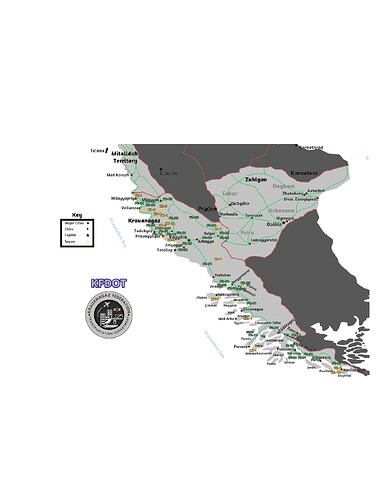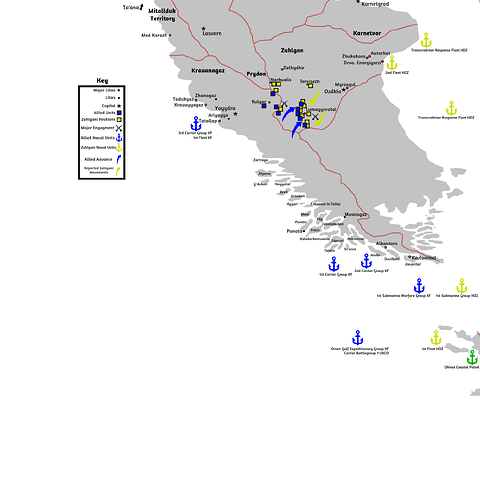Conflict in the Gulf of Good Omen Escalates as Allied Forces Push Deeper into Zuhlgan
Southern Cordilia – The conflict between Krauanagaz, Emerald, and Zuhlgan has entered a crucial phase as allied forces continue their advance beyond the Luzayyagaz Mountains, facing stiff resistance from entrenched Zuhlgani forces. This marks the second week of the offensive that began on October 7, pushing the conflict toward a wider regional crisis. Both governments issued fresh statements today, each accusing the other of war crimes, deepening the mistrust between the Gulf powers.
Krauanagazan and Emeraldian military commands have emphasized that maintaining pressure on Zuhlgani defenses is key to their strategy. Chief of Staff of Krauanagaz’s Federal Army, General Markus Vinton, issued a statement at a press briefing this morning, saying, “The coalition will not relent. Every day our troops are advancing deeper, disrupting supply routes and diminishing enemy capabilities. We aim not for conquest, but stabilization of the borderlands.”
Vinton also revealed that allied mechanized forces had successfully broken through parts of the Prira region, bypassing heavily defended areas through flanking maneuvers supported by Emeraldian air cover. Ozákla remains a primary objective, with forces advancing from multiple fronts. Securing the city will grant the allies control over critical roads and supply networks linking southern Zuhlgan to its interior.
Krauanagaz, Mitallduk, and Zuhlgan major roads map. (2020)
According to the Krauanagazan Defense Department, allied naval units remain deployed in strategic positions across the Gulf of Good Omen. The Krauanagazan 3rd Carrier Group has been instrumental in providing air support for advancing troops, while Emerald’s Carrier Battlegroup 7 has engaged in patrols to disrupt Zuhlgani maritime operations in the Gulf. Military experts suggest that naval supremacy could shift the balance of power, although Zuhlgani naval units have thus far prevented the allied fleet from advancing into the Transcrabrian Sea.
Despite the early successes of the allied campaign, Zuhlgan has launched a counteroffensive aimed at halting the Krauanagazan and Emeraldian advance in the Luzayyagaz Mountains. In a broadcast from the capital Ozákla, Autark Apovi Ibinete denounced the invasion as an, "imperialist campaign, ’ and vowed to “break the invaders’ will.” Zuhlgani forces, using elaborate underground defensive structures and knowledge of the mountainous terrain, have reportedly inflicted heavy casualties on advancing units.
According to a senior defense official, speaking on the condition of anonymity, a counterattack was launched late last night near Lumayyaratal involving Zuhlgani commandos targeting allied supply lines with ambushes and improvised explosive devices (IEDs). Military analysts warn that as allied troops push further into Zuhlgani territory, they risk becoming bogged down in prolonged, attritional warfare. Lumayyaratal, considered the gateway to the southern interior, has become a key focal point in the battle. Zuhlgani forces have fortified positions in the area and continue to conduct hit-and-run attacks, aiming to stretch allied supply lines thin.
Reports from humanitarian groups describe a deteriorating situation in several urban centers along the frontlines. Thousands of residents have fled from Lumayyaratal, Ozákla, and Rulgaz as bombardments intensified. Local authorities in Krauanagaz have confirmed that refugee camps in the ‘safe zone’ are, “well over capacity,” raising fears of a new humanitarian crisis. Kraudukra Human Rights Watch (KHRW) has called for a ceasefire to allow civilians to escape combat zones, warning that continued fighting could lead to a mass displacement event.
In the wake of growing international pressure, a spokesperson for the Allied forces, General Iwan Albrán, defended the campaign stating, “We understand the human toll this conflict carries, but we cannot tolerate the destabilizing influence Zuhlgan has exerted in the Gulf. This campaign is a necessary intervention to restore peace and security to the region.”
Zuhlgan’s Ministry of Foreign Affairs, however, has accused Krauanagaz and Emerald of deliberately targeting civilian infrastructure. Autark Kula H’kara reiterated these claims earlier today saying, “The so-called precision strikes are nothing more than barbaric acts designed to terrorize our population into submission. Zuhlgan will not stand for such aggression.” Krauanagaz and Emerald deny these claims, saying their forces only fire on military infrastructure, The Scope was unable to independently verify either claim.
As the conflict conflagrates, neighboring states such as Prydon and Karnetvor have placed their military forces on alert. Diplomatic sources suggest that Prydon’s government is particularly concerned about potential spillover into its border regions, with reports indicating it has begun fortifying positions near its southern border.
Meanwhile, international naval forces continue to crowd the waters of the Gulf of Good Omen. Izaakian units, operating under Operation Turquoise Seas, have stepped up patrols to secure vital shipping lanes, wary of a possible naval incident. With both allied and Zuhlgani warships now in close proximity, analysts fear that any miscalculation could spark an international crisis with a third-party. This has led to accusations from both Krauanagazan and Zuhlgani leadership that outside powers are seeking to exploit the conflict for strategic advantage.
In light of the deteriorating situation, diplomatic efforts to de-escalate the conflict have gained urgency. The World Forum (WF) issued a statement today calling for an immediate ceasefire and the initiation of peace talks. However, neither Krauanagaz nor Zuhlgan has shown any signs of backing down.
Emerald’s foreign ministry dismissed the WF’s statement, arguing that, “peace without accountability,” would allow Zuhlgan to rearm and reignite regional instability in the future. On the other hand, Zuhlgan insists that no negotiations can proceed unless allied forces withdraw from their territory.
As of October 14, fighting continues along the Krauanagaz-Zuhlgan border, with no clear resolution in sight. Military and political leaders on both sides appear determined to press forward, despite reportedly mounting casualties and international calls for restraint. Observers warn that the coming weeks could prove decisive, as both the allied coalition and Zuhlgani forces appear to be gearing up for an intensification of the conflict.


